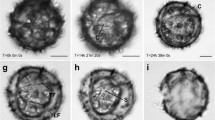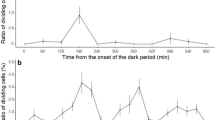Abstract
The meiotic process inNoctiluca scintillans were observed under light microscope. Some abnormal cell divisions, incompletely separated “zoospores” and the changes of the zoospores are described in this paper. Together with the findings of field samplings and the previous results by other researcher, the process of meiosis inN. scintillans was supposed to be a pathway to reduce the extra high density of NH3−N within the cell in order to ensure normal population growth.
Similar content being viewed by others
References
Elbrachter, M., 1991. Food uptake mechanisms in phagotrophic dinoflagellates and classification.In: Patterson D. J., Larsen J., (eds). The biology of free-living heterotrophic flagellate. (Systematic Association Special Volume) 45: 303–312.
Helmstetter, C. E., 1974. Initiation of chromosome replication inEschrichia coli II. Analysis of the control mechanism.J. Mol. Biol. 84:31–36.
Kirchner, M., Sahling, G., Uhlig, G. et al.,1996. Does the red tide-forming dinoflagellateNoctiluca scintillans feed on bacteria?Sarsia 81: 45–55.
Lucas, I. A. N., 1982. Observations onNoctiluca scintillans Macartney (Ehrenb.) (Dinophyceae) with notes on an intracellular bacterium.J. Plankton Res. 4: 401–409.
Okaichi, T., 1976. Identification of ammonia as the toxic principle of red tide ofNoctiluca miliaris.Bull. Plankton. Sco. JPN. 23(2): 25–30.
Omori, M., Hammer, W. M., 1982. Patchy distribution of zooplankton: Behavior population assessment and sampling problems.Mar. Biol. 72: 193–200.
Parker, D. L., Glaser, D. A., 1974. Chromosomal sites of DNA-membrane attachment inEscherichia coli.J. Mol. Biol. 87: 153–168.
Qi, S., Li, D., 1994. Unequal cell division ofNoctiluca scintillans.Oceanogr. Limnol. Sinica 25: 158–161.
Sato, M. S., Suzuki, M., Hayashi, H., 1998. The density of a homogeneous population of cells controls resetting of the program for swarner formation in the unicellular marine microorganismNoctiluca scintillans.Exp. Cell. Res. 245(2): 290–293.
Schaumann, K., 1988. Hydrographic and biological characteristics of aNoctulica scintillans red tide in the German Bight, 1984. Meeresforschung/REP.Mar. Res. 32(2): 77–91.
Schnepf, E., Drebes, G., 1993. Anisogamy in the dinoflagellateNotiluca? Helgolaender Meeresunters 47: 265–273.
Singarajah, K. V., 1979. Ionic regulation as buoyancy mechanism inNoctiluca miliaris andPleurobrachia pileus.Rev. Bras. Biol. 39(1): 53–66.
Tiselius, P., Kiorboe, T., 1998. Colonization of diatom aggregation by the dinoflagellateNoctiluca scintillans.Limnol. Oceanogr. 43(1): 154–159.
Uhlig, G., Sahling, G., 1995.Noctiluca scintillans: Zeitliche Verteilung bei Helgoland und raumliche Verbreitung in der Deutschen Bucht (Langzeitrehen 1970–1993).Ber. Biol. Anst. Helgoland 9: 1–127.
Zingmark, R. G., 1970. Sexual reproduction in the dinoflagellateNoctiluca miliaris Suriray.J. Phycol. 6: 122–126.
Author information
Authors and Affiliations
Additional information
Contribution No. 4134 from the Institute of Oceanology, Chinese Academy of Sciences.
Project No. 39600028 and No. 3790110 supported by NSFC.
Rights and permissions
About this article
Cite this article
Cheng-xu, Z., Xiao-jun, Y. New observations on the meiotic process in the marine dinoflagellateNoctiluca scintillans (Noctilucales, dinophyceae). Chin. J. Ocean. Limnol. 20, 67–73 (2002). https://doi.org/10.1007/BF02846613
Received:
Accepted:
Issue Date:
DOI: https://doi.org/10.1007/BF02846613




